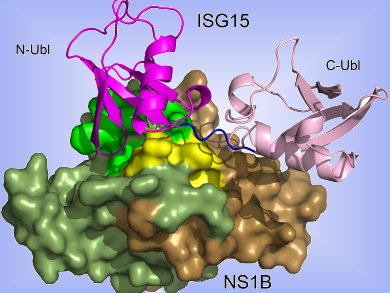The influenza B virus has been found only in humans. Understanding why this is could lead to improved understanding of how the more virulent influenza A strains are able to cross species and ways to prevent it.
Gaetano Montelione and colleagues, Rutgers University, New Jersey, USA, have determined the crystal structure of the influenza B virus and identified its target protein. The N-terminal region of protein NS1B (pictured as the solid form) interacts with two interferon-stimulated gene 15 (ISG15) molecules (pink and purple). The primary contact region is composed of residues at the junction of the N-terminal ubiquitin-like (Ubl) domain and the short linker region between the two Ubl domains.
Only human and non-human primate ISG15 proteins have this sequence of short linker (blue) which explains why influenza B cannot infect other species.
Image: © Rongjin Guan, et. al. Rutgers and Univ. of Texas, Austin
- Structural basis for the sequence-specific recognition of human ISG15 by the NS1 protein of influenza B virus
R. Guan, L.-C. Ma, P. G. Leonard, B. R. Amer, H. Sridharan, C. Zhao, R. M. Krug, G. T. Montelione,
Proc. Natl. Acad. Sci. 2011, 108(33), 12468—13473.
DOI: 10.1073/pnas.1107032108




